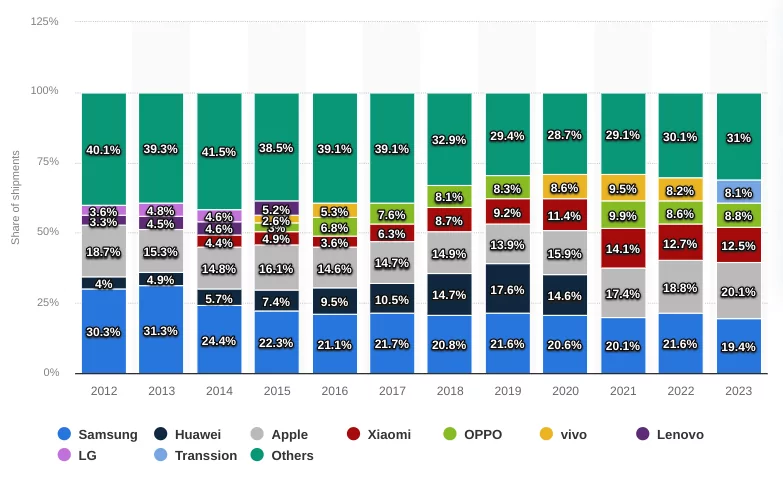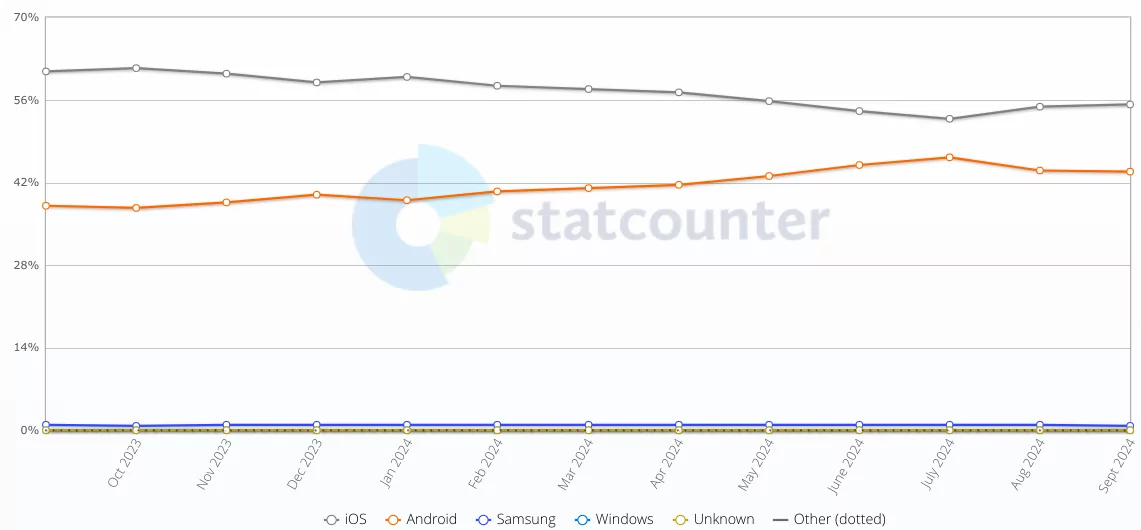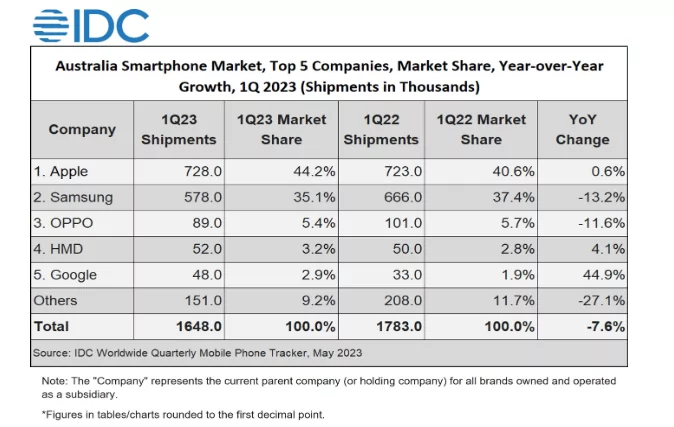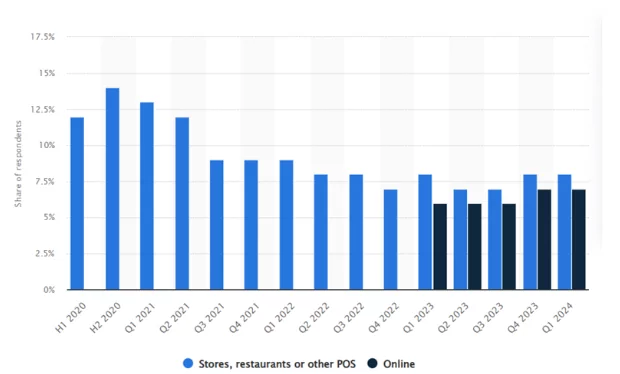
- Red Search
- Resources
- Samsung Mobile Phone Statistics Australia
Samsung Mobile Phone Statistics Australia
-
 Daniel Law
Daniel Law
Today, handheld computers such as smartphones offer various functions, user-friendliness, and accessibility. When pushing these digital boundaries, Samsung provides the best innovations tailored to consumer needs.
Samsung’s smartphones have impressive lists of statistics that cemented its status as a global force in the smartphone industry.
Samsung Market Share in Australia
Samsung’s dominance in mobile phones started in the late 1980s. With its decade-long reputation in the mobile phone industry, it cemented itself as one of the top tech conglomerates globally.
Samsung is undoubtedly a household name. Its products include household appliances, televisions, smartwatches, wearables, and an extensive series of mobile phones.
Samsung Electronics’ mobile experience (MX) generated approximately US$24 billion worldwide in mid-2024. Although this does not directly translate to smartphone revenue, such value has declined recently.
Despite being a consistent front-row competitor in the global smartphone industry, Samsung lagged with only 19.4% market share in 2023, second to Apple’s 20.1% share.
Global Smartphone Market Share (2012-2023)

Source: Statista
It’s a no-brainer that Apple holds the highest mobile operating system in Australia. As of 2024, Android OS has a 46.21% market share, closing the gap with iOS at 52.77%.
Samsung’s leading presence among Android phones can catapult its user reach with the decreasing gap in the country’s operating systems.
However, this likely allows other Android brands to stiffen the Australian smartphone market.
Mobile Operating System Market Share Australia
Sept 2023 – Sept 2024

Source: Statcounter Global Stats
Samsung Mobile Phone Sales Trend
In 2023, the South Korean tech firm sold 226 million units, 8 million fewer than iPhones’ 234.6 million units. This margin ended Samsung’s 12-year reign as the world’s top mobile phone seller.
In the same year, newer models halted Samsung’s plummeting revenue after its shipment declined by 13.2% across Australia. On the positive side, the shipment for premium segments (US$1000) like the Galaxy S23 series remained high.

Source: IDC
With many brands using the Android operating system, the race to design the most advanced smartphones boosts Android’s overall market share.
In the Telsyte Australian Smartphone & Wearable Devices Market Study 2022-2026, Android phones are gaining shares among consumers who opt for competitively priced smartphones.
Furthermore, the same study underscores that 1 out of 3 iPhone users are interested in foldable mobile devices. The Galaxy Z series maintains increased sales because the company nearly monopolised the foldable device market.
Recognising the best Samsung smartphones among Australians doesn’t require you to be an Android enthusiast. Here are some of the best Samsung phone choices out there:
- Best Samsung Phone Overall: Samsung Galaxy S24 Ultra
- Best Cheap Samsung Phone: Samsung Galaxy A55
- Best Small Samsung Phone: Samsung Galaxy S24
- Best Foldable Samsung Phone: Samsung Galaxy Z Flip5
Samsung Smartphone User Demographics
The estimated increase in smartphone users in Australia will reach 23.6 million by 2026. That’s 87% of the country’s population, emphasising how smartphones have become essential for Aussies’ day-to-day activities.
Over 9 million Australians use Samsung, one-third of the country’s population. The company’s scaled-up user reach owes to the brand’s reliability and wide selection at every price point.
Among Australian users, 61% of Samsung mobile phone owners are male, while only 39% are female. Here’s the age breakdown of Samsung smartphone users among Aussies:
- Ages 18-24: 21.7%
- Ages 25-34: 27.6%
- Ages 35-44: 17.6%
- Ages 45-54: 11.4%
- Ages 55 and above: 21.8%
Also known as digital natives, about 27.6% of Samsung users are aged 25 to 34. A likely contributor to Samsung’s popularity in this age range is social media usage, which is widely sought-after by adolescents and young adults.
Samsung Mobile Phone Usage Statistics
With around a quarter of the country’s smartphones being Samsung, the intriguing question poses how connected Australians are with their smartphones.
Samsung mobile phone users spend an average of 2.5 hours daily. Aside from this, these mind-boggling facts might be interesting for tech-savvy like you:
- 78% of Samsung users prefer Android OS over other operating systems
- 25% of Samsung users are more likely to own other smart home devices compared to other smartphone users
- 60% of Samsung users are likely to purchase new models within the next year
- 70% of Samsung users prioritise camera quality when choosing smartphones
- 20% of Samsung users are more likely to engage in virtual reality content than other brand users
- 18% of Samsung users are more likely to watch video content daily
- 20% of Samsung users use their phones for mobile gaming
- 58% of Samsung users use their smartphones for social media networking
Samsung users’ typical household income is 15% higher than the national average. Yet, 22% of Samsung users will likely keep their smartphone for about two years before upgrading.
Here’s the top list of Samsung smartphone devices in the Australian digital landscape:
1. Samsung Galaxy S21 5G
2. Samsung Galaxy S9
3. Samsung Galaxy S21 Ultra 5G
4. Samsung S8
5. Samsung Galaxy S9+
The trend for Samsung Pay is also increasing, with more users purchasing in stores, restaurants, or even online shops.
Newer Samsung devices use NFC, MST, or MoBeam technologies that allow you to make seamless, contactless payments.
A tad higher during the pandemic, about 8% of users utilised Samsung Pay with their mobile phones to pay for in-stores, restaurants, and other POS in early 2024. Only 7% use a similar payment method when paying online.
Samsung Pay will be used for online payments or at POS in Australia from 2020 to the first quarter of 2024.

Source: Statista
In a survey from Statista Consumer Insights, roughly one out of 10 Australians uses Samsung Pay when purchasing various products. Still, 65% of Samsung users worldwide prefer Samsung Pay for mobile payments.
Furthermore, Play Store’s 3.553 million readily downloadable mobile apps elevate Samsung users’ experience to a degree. To date, 96.9% of these apps are free!
As a titan in the tech industry, Samsung’s Android devices account for over half of Google Play Store’s revenue. It is not surprising as Samsung devices have pre-installed the app.
Besides that, the Samsung Galaxy Store attracts more consumers who opt for exclusivity with its features, themes, and other customisations tailored to the brand’s electronic devices.
Samsung Phones and 5G Adoption
The end of 3G puts Australian telecommunication companies in a difficult situation as they try to roll out the massive scope of 5G by the end of 2024.
5G is set to deliver 10 Gbps of internet speed instantaneously. Theoretically, Australia’s current 5G can hit speeds up to 1Gbps, sometimes slower in less ideal conditions.
Such connectivity can improve if 5G coverage widens to reach rural areas with more compatible smartphones. That’s where Samsung enters the story, as its newer model launches are increasingly 5G-compatible devices.
A rule of thumb for 5G-enabled Samsung users, it’s essential to check if 5G is in your neighbourhood. If not covered, it’s another case of wait-and-see, as telcos don’t have a specific 5G rollout schedule.
What telco offers the best 5G coverage
Currently, Telstra’s 5G coverage spans 87% of Australia. This massive coverage is not unexpected, as Telstra remains the country’s largest telco.
But it’s another tale about 5G’s quality, speed, and reliability among Australians.
How 5G improves Samsung smartphones
Samsung was the swiftest to switch to the 5G network, but it didn’t last long after other smartphone brands joined the bandwagon.
The burgeoning demands for mobile digitisation require a huge leap forward in technology. That’s how 5G benefits Samsung smartphone users, providing a myriad of next-level user experiences in terms of:
- Peak Data Rate (Gbps): Designed to achieve 20 Gbps, virtually making all digital transactions as swift as flicking a switch.
- User Experience Data Rate: Designed to achieve 100 Mbps (downlink) and 50 Mbps (uplink), ensuring improved data speed, coverage, and user experience.
- Energy Efficiency: Targeted to improve 90% in spectral efficiency compared to 4G. It’s an initial step to lower energy use in cell sites and electronic devices.
- Connection Density (devices per km2): 5G accommodates 1 million devices per square kilometre, an immense difference from 4G’s 4,000 devices.
How 5G enhances Samsung user experience
The 5G technology allows more Samsung smartphone users to stream high-definition content, keep up with real-time health and wellness tracking, and immerse players in graphics-heavy AR and VR games.
Samsung designed its recent devices to leverage the advantages of 5G technology. For example, Galaxy S24 and S24+ offer premium features and performance suited to 5G compatibility.
The company even released Galaxy A series and Galaxy S23 FE at lower prices, equipped with 5G support to enhance connectivity.
Here’s the list of Australia’s top 5G-enabled Samsung mobile phones based on customer reviews, trends, and popularity.
- Samsung Galaxy A55 5G
- Samsung Galaxy A54 5G
- Samsung Galaxy A15 5G
- Samsung Galaxy A55 5G
- Samsung Galaxy A25 5G
With 5G being the fastest mobile data out there, it helps you revolutionise how you live online. However, Samsung, an innovation leader among tech companies, aims to surpass this with 6G technology by 2030.
Samsung 5G network user satisfaction
Among the 5G smartphones in the market, Samsung has reached the apex of customer satisfaction in the US. However, no data supports that this is also the case for Samsung mobile phone users in Australia.
Samsung Environmental Statistics in Australia
Selecting the best smartphone device is a tedious task, considering there will be 24 million smartphone users by 2026, each preferring many smartphone features.
Beyond impressive features, our collective goal is to promote gadgets designed to be environmentally friendly. Samsung fits that big shoe, as it surpasses heaps of environmental drawbacks.
Samsung embeds eco-conscious innovation and technology in their recent smartphone models. The company takes sustainability up a notch.
Samsung Lowers Smartphones Carbon Emission
Samsung commits to reducing carbon emissions from its production, distribution, use, and disposal at every stage of its life cycle. For instance, the company develops and uses recyclable materials in the production stage to lower its carbon footprint.
Newer Samsung smartphones have lower carbon emissions based on their entire life cycle.
- Galaxy S23: 54.0 kg CO2 equivalent
- Galaxy S23+: 58.8 kg CO2 equivalent
- Galaxy Ultra S24 Ultra: 66.4 kg CO2 equivalent
- Galaxy Z Fold6: 60.6 kg CO2 equivalent
- Galaxy Z Flip6: 42.8 kg CO2 equivalent
Contextually, multiplying these figures into millions adversely affects the climate. That’s why patronising eco-conscious devices is an indirect step to save the planet.
Samsung Phones Ingenious Sourcing
In addition to keeping the planet out of harm’s way, Samsung recycles various materials, such as aluminium, glass, and discarded PET water bottles.
By 2030, the company’s bucket list includes integrating 50% recycled plastic resin into its digital transformation products.
Samsung maximises its effort to utilise recyclable materials in its smartphone products.
- Plastic: 20% recycled plastics are present in Galaxy S23 and S23+
- Aluminium: 28% of Galaxy S23, S23+, S24, and newer models consists of recycled aluminium
- Glass: Over 20% pre-consumer recycled glass is present in Samsung phones
- Rare Earth Elements: 100% recycled magnets exist in 2024 Samsung models
- Gold & Copper: 100% recycled gold and copper in Galaxy Fold Z Fold6 & Flip6
Samsung Smartphone Eco-Packaging
Samsung’s commitment to eco-packaging is top-notch. Most of its recent mobile phones have astounding efforts to eliminate single-use plastics in packaging.
- Less than 2% plastic in packaging
- Over 96% reduced plastic in the packaging (Samsung S series & Galaxy Z items)
- 100% recycled paper in all of its items
Samsung Sustainable Smartphone
Extending the longevity of Samsung smartphones is critical to ensuring sustainable smartphone use. Compared to 2019 models, newer Samsung smartphones reduced energy consumption by 30% to lessen carbon emissions in the use phase.
Repairability also extends product life. Samsung expands the number of authorised service providers to bolster its product repairs.
Other features and initiatives are integral to prolonging device life, such as water resistance, dust protection, and maintaining security and OS updates (5 years & 4 gen).
Samsung Mobile Phone Recycling Efforts
On a global scale, Samsung has mobile phone and accessory collection boxes at repair centres around 34 countries. The company has unique local recycling programs in each region that optimally collect, dispose of, and recycle regardless of the products’ brands.
Future Growth of Samsung Smartphones in Australia
The Australian smartphone industry is bound to reach US$3.5 billion in revenue in the next five years. This value might skyrocket as smartphone users’ preferences continue to evolve.
Samsung maintains its position as a top market leader, offering a wide range of price points from the cheapest to the premium smartphones. Its premium foldable phones are hot on the trail, widening its popularity among Australian mobile phone users.
Key Takeaways
Samsung’s decade-long track record, top-tier creativity, innovation, and sustainability prove its precise portrayal of being a game-changer in the Australian digital landscape.
The company’s competitive edge is adding hype to Australian smartphone trends. That’s why optimising your business digital presence to evolve consumer preferences becomes crucial.
Digital platforms unlock boundless opportunities to scale brand visibility and reach. As a Sydney SEO Agency, we strategise to help businesses create lasting impressions tailored to an infinite digital audience.
For more on Australian statistics, see our other articles:
Warning: Undefined array key "hide_icon" in /www/redsearch_236/public/wp-content/plugins/elementor/includes/conditions.php on line 87
Deprecated: strtolower(): Passing null to parameter #1 ($string) of type string is deprecated in /www/redsearch_236/public/wp-content/plugins/premium-addons-pro/includes/papro-helper.php on line 53
Written by:

Daniel Law
Warning: Undefined array key "hide_icon" in /www/redsearch_236/public/wp-content/plugins/elementor/includes/conditions.php on line 87
Deprecated: strtolower(): Passing null to parameter #1 ($string) of type string is deprecated in /www/redsearch_236/public/wp-content/plugins/premium-addons-pro/includes/papro-helper.php on line 53





